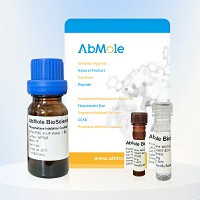All AbMole products are for research use only, cannot be used for human consumption.

Osteopontin/SPP1 is a secreted multifunctional glycoprotein. Its putative functions include roles in bone metabolism, immune regulation, wound healing, cell survival, and tumor progression. Osteopontin/SPP1 acts as a cytokine that is involved in enhancing production of interferon-gamma and interleukin-12 and reducing production of interleukin-10. It is essential in the pathway that leads to type I immunity. Osteopontin has been implicated as an important factor in bone remodeling. Specifically, research suggests it plays a role in anchoring osteoclasts to the mineral matrix of bones. The fact that SPP1 interacts with multiple cell surface receptors which are ubiquitously expressed makes it an active player in many physiological and pathological processes including wound healing, bone turnover, tumorigenesis, inflammation and ischemia.
Recombinant Human Osteopontin/SPP1 is produced by Mammalian expression system and the target gene encoding Ile17-Asn314 is expressed with a 6His tag at the C-terminus.
Accession: P10451
APMol Mass: 60-70 KDa, reducing conditions
Endotoxin: < 1 EU/µg as determined by LAL test
Lyophilized from a 0.2 μm filtered solution of PBS, pH 7.4.
| Solubility (25°C) | Dissolve the lyophilized protein in distilled water. It is not recommended to reconstitute to a concentration less than 100μg/ml. |
| Storage | Stored at ≤ -20°C, stable for one year after receipt. Reconstituted protein solution can be stored at 2-8°C for 2-7 days. |
[1] Itai Rotem, et al. Basic Res Cardiol. Osteopontin promotes infarct repair
| Related Cytokines and Growth Factors Products |
|---|
| Recombinant Human GDF-15 Protein (HEK293 N-hFc)
Growth-differentiation factor 15 (GDF15), also known as MIC-1, is a secreted member of the transforming growth factor (TGF)-β superfamily. GDF-15 has a role in regulating inflammatory and apoptotic pathways in injured tissues and during disease processes. GDF-15 overexpression arising from an expanded erythroid compartment contributes to iron overload in thalassemia syndromes by inhibiting hepcidin expression. |
| Recombinant Human FGFR1 Protein (HEK293, C-His)
FGFR1, also known as CD331, is a full-length representative protein consists of an extracellular region, composed of three immunoglobulin-like domains, a single hydrophobic membrane-spanning segment and a cytoplasmic tyrosine kinase domain. |
| Recombinant Human FGFR2 Protein (HEK293, C-His)
FGFR2, also known as CD332, acts as cell-surface receptor for fibroblast growth factors and plays an essential role in the regulation of cell proliferation, differentiation, migration and apoptosis, and in the regulation of embryonic development. FGFR2 plays an essential role in the regulation of osteoblast differentiation, proliferation and apoptosis, and is required for normal skeleton development. It also promotes cell proliferation in keratinocytes and imature osteoblasts, but promotes apoptosis in differentiated osteoblasts. |
| Recombinant Mouse BMP-4 Protein (E. coli, C-His)
Bone Morphogenetic Protein-4 (BMP-4) is a critical signaling molecule required for the early differentiation of the embryo and establishing of a dorsal-ventral axis. BMP-4 is secreted from the dorsal portion of the notochord, and it acts in concert with sonic hedgehog to establish a dorsal-ventral axis for the differentiation of later structures. |
| Recombinant Human Coagulation Factor X (HEK293, C-Fc)
Coagulation factor X, belongs to the peptidase S1 family. Coagulation factor X is initially synthesized in the liver. Coagulation factor X is a vitamin K-dependent glycoprotein that converts prothrombin to thrombin in the presence of factor Va, calcium and phospholipid during blood clotting. |
All AbMole products are for research use only, cannot be used for human consumption or veterinary use. We do not provide products or services to individuals. Please comply with the intended use and do not use AbMole products for any other purpose.


Products are for research use only. Not for human use. We do not sell to patients.
© Copyright 2010-2024 AbMole BioScience. All Rights Reserved.
